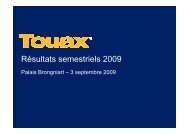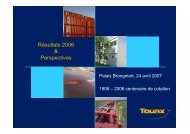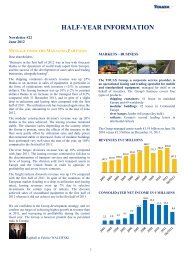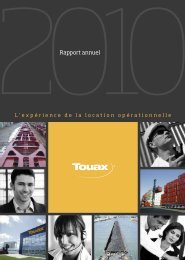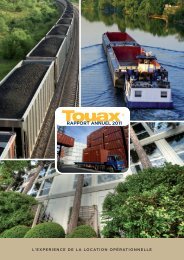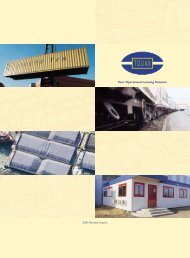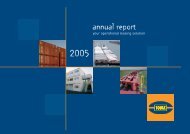2010 annual report - touax group
2010 annual report - touax group
2010 annual report - touax group
You also want an ePaper? Increase the reach of your titles
YUMPU automatically turns print PDFs into web optimized ePapers that Google loves.
Annual <strong>report</strong> <strong>2010</strong><br />
Other Non-Current Financial Assets and other fixed assets are<br />
valued at cost and amortized using the effective interest rate; it<br />
is considered that their book values are a reasonable approximation<br />
to fair value.<br />
Other Non-Current Financial Assets and other fixed assets<br />
undergo impairment tests on the basis of the estimated future<br />
income streams. Impairments amounting to €6.7 million have<br />
been booked in earlier financial periods (before 2008). In 2009,<br />
a €1 million impairment was booked on the deferred payment<br />
of EIG management commissions concerning the Group, as<br />
well as a €2.1 million impairment on liquidity reserves granted<br />
to the Trusts 2001 (see the appendix to the consolidated financial<br />
statements, note 30.1 and note 30.3).<br />
❙ note 18.1.1. Trade receivables and other receivables<br />
On first booking, trade receivables and related accounts are<br />
recognized at their fair value which corresponds to their nominal<br />
value. They may be written down if there is a risk the debt<br />
may not be collected in full. The item appears in the Balance<br />
Sheet on December 31, <strong>2010</strong> at an amount of €57 million: this<br />
book value is a reasonable estimate of the fair value.<br />
Mean aging of trade receivables is 64 days. A provision is set<br />
aside for any receivables in arrears by less than one year; its<br />
amount depends on the customer’s payment history.<br />
Before a new customer is accepted, the Group checks its solvency<br />
with credit rating agencies and determines the applicable<br />
credit limits.<br />
As of December 31, <strong>2010</strong> the Group’s books included<br />
€16 million net of receivables in arrears.<br />
Aged trial balance<br />
(€ thousands) Gross accounts Provisions Accounts<br />
receivable<br />
receivable<br />
Not due 40,740 (213) 40,527<br />
0-6 months 11,540 (473) 11,067<br />
6-12 months 4,205 (988) 3,216<br />
> 1 year 8,650 (6,471) 2,180<br />
TOTAL 65,134 (8,144) 56,990<br />
❙ note 18.1.2. Credits under finance leases<br />
The Group’s assets include moneys owed to it under finance leases, in which it is the lessor, amounting to a net bookable value of<br />
€11.7 million and a cost price of €16.1 million.<br />
(€ thousands) Minimum future Discounted minimum<br />
payments<br />
future payments<br />
< 1 year (+) 3,223 1,910<br />
2 - 5 years (+) 10,985 7,160<br />
> 5 years (+) 2,974 2,628<br />
Total 17,182 11,698<br />
Discounting of finance leases (-) (5,484)<br />
Discounted minimum future payments 11,698 11,698<br />
Presentation in the balance sheet of finance lease receivables:<br />
Other current assets 1,910<br />
Other non-current assets 9,788<br />
TOTAL 11,698<br />
The interest rate applied in each finance lease is determined on<br />
the day the contract is signed. The mean rate of interest used<br />
in the accounts was 9.91% on December 31, <strong>2010</strong>. The interest<br />
income from finance leases is recorded under leasing income<br />
(€2.1 million in <strong>2010</strong> compared with €1.2 million in 2009 and<br />
€973 thousand in 2008).<br />
The total amount of customer repayments of principal lent<br />
under finance leases (the principal appears as a net investment<br />
among Balance Sheet assets) was €2 million in <strong>2010</strong> versus<br />
€1.8 million in 2009 and €1.9 million in 2008.<br />
The EBITDA – understood by the Group as current operating<br />
income less amortization charges and provisions – is not itself<br />
an accounting concept. However, it is very often used by financial<br />
analysts, investors and other users of Financial Statements<br />
as a measure of the operating performance of a business. In<br />
TOUAX’s view, users of the Group’s Financial Statements would<br />
find the re-stated EBITDA shown below to be a better measure<br />
of this performance. Re-stated EBITDA is EBITDA plus these<br />
capital repayments of the net investment in finance leases<br />
accorded to customers: it allows a more accurate calculation<br />
than does customary EBITDA of the size of the income stream<br />
from these transactions. The practice is widespread among<br />
firms which lease out equipment.<br />
78



